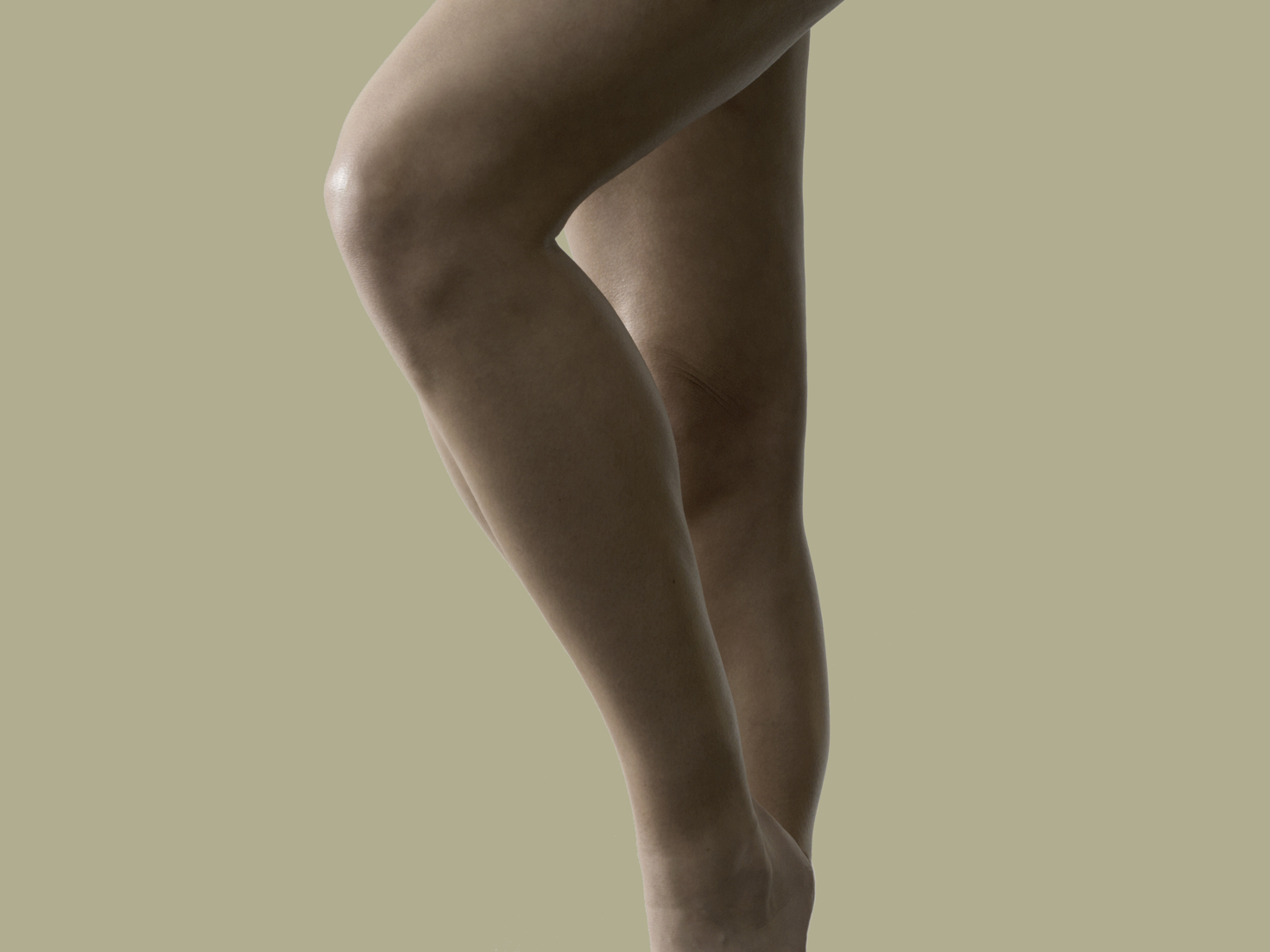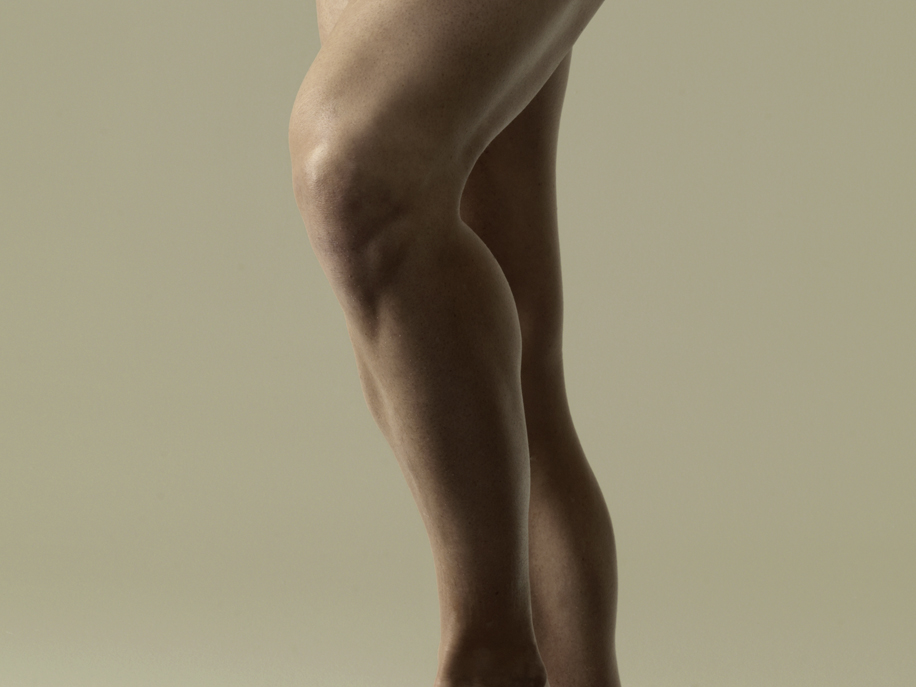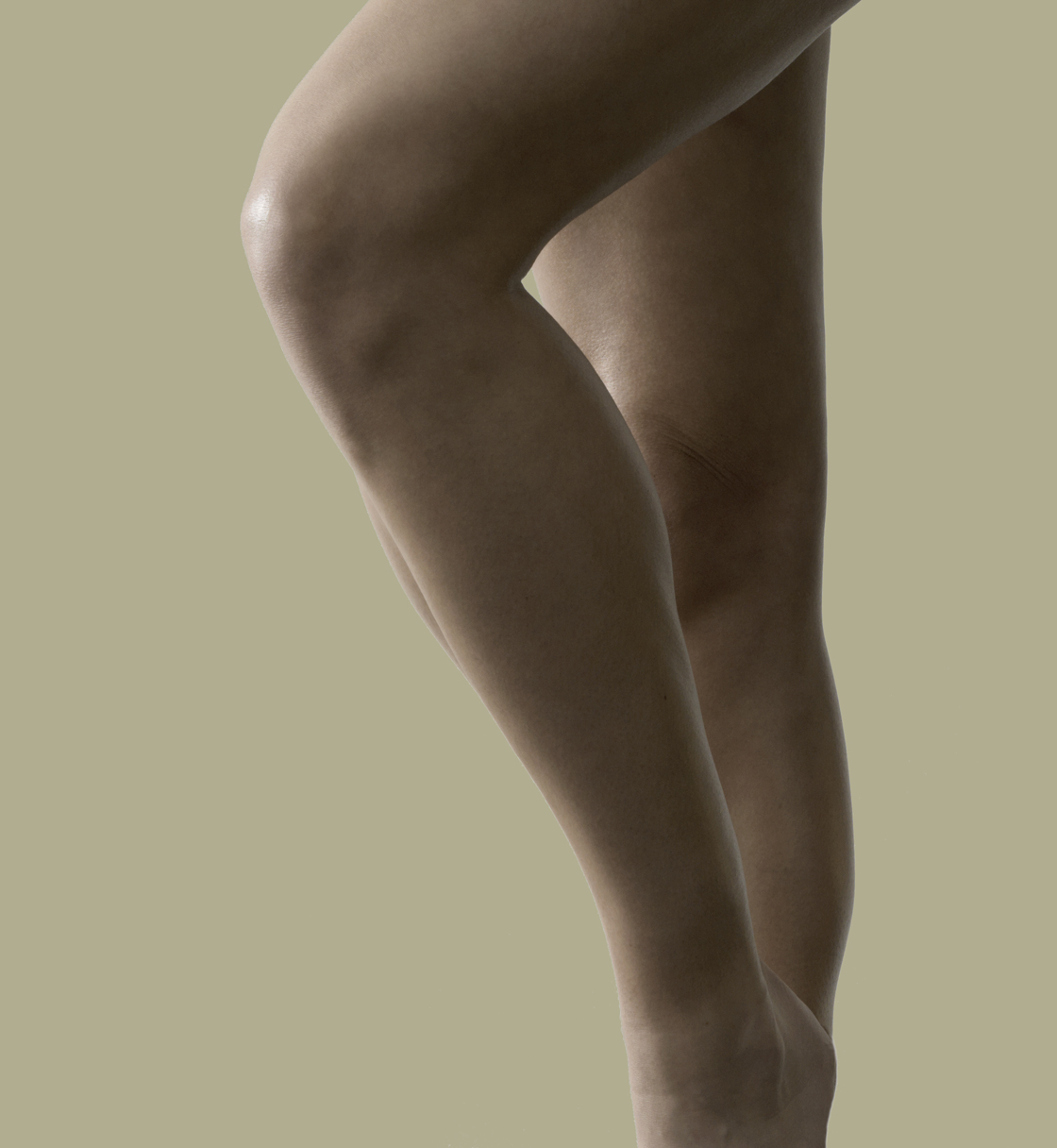
Calf augmentation or reshaping is used to enhance leg contour by increasing calf volume or correcting their shape. Women with the desire for leaner calves with a better contour can benefit from having liposuction. Women who may want fuller and better defined calves can undergo calf enlargement (calf augmentation) either with implants or autologous fat (lipofilling). Reshaping of the calves can also be achieved through a combination of liposuction and lipofilling. Calves that are too slender may be due to underdeveloped calf muscles, whilst over-sized calves may be due to lipedema or lymphedema. Hereditary factors also play a role.

Considerations
When to consider calf augmentation/reshaping:
- You would like fuller and better-defined calves.
- You would like leaner and better-defined calves.
- Your calves are too thin and the muscles do not increase sufficiently by physical exercise.
- Your calves are asymmetrical or unequal in size.
- Your well-being and self-esteem are affected by the shape of your calves.
Calf augmentation increases calf volume to create a more defined shape that is not achievable by specific exercise of the calf muscles. Calf reshaping can either serve the slimming or contouring of the calves. This is achieved by removing excess fat that cannot be eliminated by other means. Even abnormal swelling of the calves due lipedema can partially be improved by surgery. Calf augmentation or reshaping procedures are possible at any age as long as there are no serious underlying medical conditions that increase the risk of surgery. A prerequisite for calf augmentation and reshaping is a stable body weight, as strong weight fluctuations may affect the surgical result. Any planned weight loss should be considered before undergoing the procedure. Severe obesity, varicose veins and calf oedema can increase the risk of surgery, significantly affect the expected result and may thus be contraindications for calf augmentation and reshaping.
Consultation
A prerequisite to a successful operation is careful planning. This starts with a personal consultation at the AARE KLINIK.
- Communication of wishes and expectations ascertain what you would like to improve.
- Explanation of the potential, scope and limitations of the operation.
Examination:
- Medical history is taken.
- The calves and adjacent parts of the body are examined while standing.
- The firmness and elasticity of the skin, the thickness of the adipose tissue, and possible swelling (oedema) are determined.
- The strength of the calf muscles is checked.
- It will be ascertained whether you need the removal of varicose veins, or treatment of lymphedema in addition to the removal of excess fat.
- If calf enlargement is required, then options with silicone implants or autologous fatty tissue will be discussed.
- Digital photos are taken.
- Individual factors and personal wishes help in jointly deciding the choice of the appropriate surgical technique, the position of incisions and the resulting scars.
- Based on this, an individual treatment plan is drawn up and goals of the operation are discussed and defined.
- Risks and possible complications are discussed and documented.
To plan the operation and to make a risk assessment we require:
- Full medical history (pre-existing conditions and previous surgery).
- Current diseases (high blood pressure, diabetes, thyroid dysfunction, etc.).
- Allergies or aversion to medications.
- In particular, information about possible diseases of the veins and lymphatic system disorders (varicose veins, thrombosis, lymphedema) are important.
- Any important medical reports (please bring any important medical information).
- If you are intending to lose a significant amount of weight to get pregnant, this should be considered when planning a calf augmentation or reshaping
- It may be advisable to wait for the stabilisation of your weight or after pregnancy before surgery is undertaken.
Procedure
Individual factors and personal preferences determine the choice of the surgical technique.
There are three basic options for calf augmentation and reshaping: an increase in calf size using silicone implants (calf augmentation) or the body’s own fat (lipofilling), a slimming of the calves by liposuction, and contouring of the calves through a combination of liposuction and lipofilling.
1. Calf augmentation with silicone implants
Silicone implants are especially useful when there is no other source of fatty tissue present elsewhere on the body. The advantages of this technique are precise planning and dimensional stability of the calf implants, which are usually placed on top of the calf muscles. Implants of different shapes and sizes are available and can be selected in the preoperative planning in accordance with the individual needs of the patient. Again, liposuction of the knees or thighs can be combined to achieve the best possible overall leg contour. The position of the scars is usually located in the hollow of the knees as they are less visible in the skin folds.
2. Calf augmentation with autologous fat injection (lipofilling)
In this technique, excess fatty tissue from other regions, such as e.g. the abdomen, hips, thighs or knees is used to enlarge or shape the calves. Removal of fat deposits from elsewhere simultaneously contributes to a better overall body shape. Adipose tissue is suctioned from areas of excess, prepared and then injected with fine cannulas into the subcutaneous tissue and muscles of the calves in order to increase calf volume and improve calf contour. The advantages of adipose tissue are that it is the body’s own tissue, which is often available in sufficient quantity, does not carry the risks of a foreign body, and is malleable.
3. Calf reduction (liposuction)
In patients with large calves with an excess of fat, liposuction alone can be used to achieve a slimmer calf shape. In individual cases, suctioned fat can also be injected to shape the calves (lipomodeling).
Calf augmentation or reshaping is usually performed under general anaesthesia as an outpatient procedure or with an over-night stay at the AARE KLINIK. In individual cases, a short inpatient stay at an affiliated private hospital may be necessary. The surgery usually takes 2–3 hours. In rare cases, drains are inserted at the end of the operation, to remove blood and wound fluid.
Risks
Calf augmentation and reshaping are common cosmetic surgery procedures. Complications, such as infection, healing problems or circulation disorders of the calf tissue are rare when surgery is conducted with the proper techniques and care. However, in individual cases a prolonged treatment or another operation may be required. Every patient should be informed of all the benefits, risks and possible complications involved.
Minor complications and side effects that usually resolve spontaneously include: bruising (hematoma), wound fluid accumulation (seroma) and swelling. Severe hematoma or seroma may require surgical evacuation to prevent further complications, such as delayed healing and infection. Some numbness of the calf skin is common after calf augmentation, but is usually temporary and improves with time.
The risk of severe complications such as circulatory disorders of the calf skin and wound healing problems along the suture lines is increased in smokers or patients with chronic diseases, such as diabetes. Combined interventions also increase the risk of complications. When using silicone implants, infections, scarring or defects of the implants are possible, which may require their removal in severe cases.
General risks
- Haematoma (bruising), bleeding and swelling
- Seroma (accumulation of wound fluid)
- Healing problems or infection
- Wound breakdown/dehiscence (separation of wound edges)
- Injury of nerves or vessels
- Numbness in area of operation (temporary or permanent)
- Circulatory problem in the calf skin (skin slough)
- Slight asymmetry
- Unsatisfactory aesthetic result
- Secondary surgery
- Thrombosis or embolism
Overall calf augmentation and reshaping are safe procedures when undertaken by an experienced plastic surgeon and patients are mostly satisfied with the results. You can help to minimise the risks by following the advice of your surgeon.
Preparation
Our aim is to make the time before and after your surgery as comfortable as possible. By following a few tips you can support our care:
- To aid the healing process, avoid smoking for two weeks before and after the operation.
- Avoid medication that increases the risk of bleeding, like aspirin, non-steroidal anti-inflammatory drugs, as well as vitamins and homeopathic remedies for two weeks prior to the operation.
- Calf augmentation and reshaping is usually performed as an outpatient procedure. Calf augmentation is usually performed under general anaesthesia. Depending on the location and extent of liposuction and autologous fat injection, lipomodeling can be performed under local anaesthesia with sedation or under general anaesthesia.
- Make sure that you can be collected and cared for by someone for 24 hours after the procedure.
Day of surgery
Calf augmentation and reshaping is usually performed as an outpatient procedure at the AARE KLINIK. If the surgery is extensive or if there are pre-existing medical conditions, surgery may be undertaken as an inpatient treatment in an affiliated private hospital. This may be the case, if calf augmentation is combined with other procedures, such as extensive liposuction or skin tightening procedures.
- During surgery you will receive various medications for your wellbeing.
- For your safety, your heart rate, blood pressure, oxygen supply etc. are monitored during the operation.
- After surgery, you will be taken to the recovery room, where you will have continued monitoring until you awaken and are able to get up.
- Compression garments will be applied to aid the healing process and to promote uniform skin contraction.
- You will be taken to the recovery room, where you will have continued monitoring until you awaken and are able to get up.
- You will be allowed to return home after a few hours.
- If you are an inpatient, you will remain in hospital under surveillance until the following day.
- Already on the day of the surgery you should get up regularly for a few minutes in order to minimise the risk of thrombosis.
- The level of pain after a calf augmentation or reshaping is usually not severe and can be compared with muscle soreness. However, in individual cases, pain may be more severe and require intensified or prolonged pain medication.
- You are advised to take mild pain relief that reduces swelling and should be continued for several days after surgery.
- In case of an ambulatory procedure, you should have someone to care for you continuously for 24 hours postoperative.
- We also provide the option of an over-night inpatient stay at the AARE KLINIK in a single room with a personal nurse care, if needed.
After surgery
- It is important to realise that recovery from an operation varies for every individual.
- Following calf augmentation or reshaping, you should rest in the first days after surgery and only walk short distances.
- The Legs should be kept in an elevated position as much as possible.
- Only take prescribed painkillers and avoid any medication that contains aspirin or other blood-thinning substances.
- You will receive additional blood thinning injections for several weeks.
- Wear the customised compression garments continuously day and night. Notify us if they are too tight or there are any other problems.
- In the first 2–5 days after the procedure, a feeling of tension and light pain will be felt in the region of the surgery.
- Calf skin may feel temporarily numb and hypersensitive. This is usually temporary. However, it may take weeks or months, in some cases even longer to return to feeling completely normal.
- Slight swelling and bruising in the area of surgery usually subsides within 2–3 weeks.
- Typically you will be back on your feet a couple of days after surgery and be able to resume your daily activities.
- If used, drains are removed in the first days after the operation, after which you can take showers again.
- Full baths and excessive heat (e.g. sauna), however should be avoided for several weeks until swelling has receded.
- Most sutures will dissolve by themselves and do not need to be removed.
- Non-dissolvable sutures are removed after one week.
- After removal of the sutures, we recommend the start of an intensive skin and scar care with rehydrating creams and light massage.
- In individual cases it may be useful to have special treatment with silicone gel or silicone pads over a period of 2–3 months.
- The fresh scars should be protected from UV radiation for at least six months, in order to prevent increased pigmentation.
- Activities that require prolonged standing can usually be resumed after 2–3 weeks.
- Compression garments should be worn for a total of 6-8 weeks.
- Physically demanding activities and sport should be avoided for several weeks.
- After surgery you will be examined at the AARE KLINIK at regular intervals, so that the healing process can be assessed until the final result is achieved.
Outcome
- Swelling and bruising may remain for some time after surgery.
- The healing process is gradual and it takes several months before the final result can be conclusively determined.
- Scars might be red or appear darker pigmented for several months, but this colour will fade with time.
- Swollen (hypertrophic) scars may require treatment with special silicone pads and cortisone injections.
- Calf augmentation and reshaping improves body shape and can enhance overall body contour.
- Patients often feel more self-confident and find it easier to wear certain clothes.
- The result of calf augmentation and reshaping is long lasting.
- However, after lipofilling the calf volume reduces over time in the first 2–3 months due to the initial swelling followed by a partial resorption of fat cells.
- If the desired calf volume is not fully attained after several months, another lipofilling can be performed.
Costs
Calf augmentation and reshaping is usually an aesthetic procedure, in which case the costs have to be carried by the patient. In exceptional cases, where there is a severe atrophy or asymmetry of the calves (e.g. after trauma or muscle paralyiss), the surgical correction may be medically indicated. In these cases, the treatment costs may be covered by health insurance after a prior cost estimation is given. The decision for, or against reimbursement depends on the recommendation of the medical officer in each individual case.
The costs of an aesthetically motivated calf augmentation and reshaping are variable and mainly depend on the complexity of the operation and the facility in which the surgery is performed (hospital or AARE KLINIK). A more accurate cost estimate can therefore be made only after a personal consultation.
The costs are composed of:
- Surgical fee (including consultation and post-operative care)
- Anaesthesia fee
- Technical infrastructure costs (AARE KLINIK/hospital)
- Inpatient hospital costs
- Calf implants
- Compression garements
- Medication
- Diagnostics (laboratory, ECG, scans, etc.)


